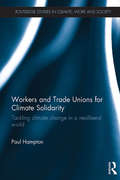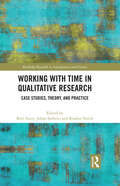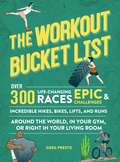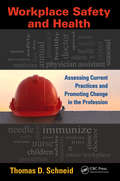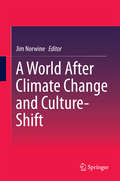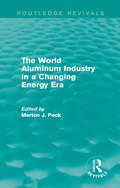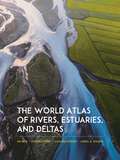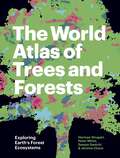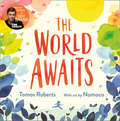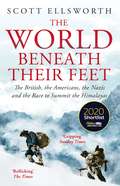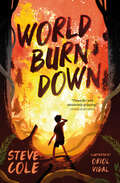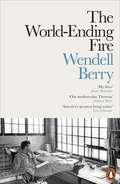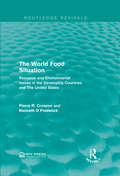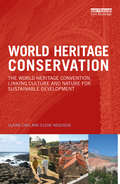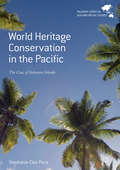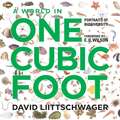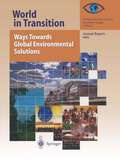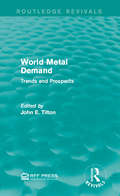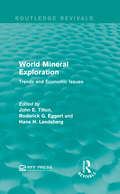- Table View
- List View
Workers and Trade Unions for Climate Solidarity: Tackling climate change in a neoliberal world (Routledge Studies in Climate, Work and Society)
by Paul HamptonThis book is a theoretically rich and empirically grounded account of UK trade union engagement with climate change over the last three decades. It offers a rigorous critique of the mainstream neoliberal and ecological modernisation approaches, extending the concepts of Marxist social and employment relations theory to the climate realm. The book applies insights from employment relations to the political economy of climate change, developing a model for understanding trade union behaviour over climate matters. The strong interdisciplinary approach draws together lessons from both physical and social science, providing an original empirical investigation into the climate politics of the UK trade union movement from high level officials down to workplace climate representatives, from issues of climate jobs to workers’ climate action. This book will be of great interest to students and researchers in environmental politics, climate change and environmental sociology.
Working with Time in Qualitative Research: Case Studies, Theory and Practice (Routledge Research in Anticipation and Futures)
by Keri FacerThis volume creates a conversation between researchers who are actively exploring how working with and reflecting upon time and temporality in the research process can generate new accounts and understandings of social and cultural phenomena and bring new ways of knowing and being into existence. The book makes a significant contribution to the enhancement of the social sciences and humanities by charting research methods that link reflectively articulate notions of time to knowledge production in these areas. Contributors explore how researchers are beginning to adopt tactics such as time visibility, hacking time, making time, witnessing temporal power and caring for temporal disruptions as resources for qualitative research. The book collects fields as disparate as futures studies and history, literary analysis and urban design, utopian studies, and science and technology studies, bringing together those who are working with temporality reflexively as a powerful epistemological tool for scholarship and research inquiry. It surfaces and foregrounds the methodological challenges and possibilities raised. In so doing, this collection will serve as a resource for both new and experienced researchers in the humanities and social sciences, seeking to understand the tools that are emerging, both theoretical and methodological, for working with time as part of research design. This book will be of great interest to students and scholars of research methods, time and temporality, future studies, and the environmental humanities.
Working with Time in Qualitative Research: Case Studies, Theory and Practice (Routledge Research in Anticipation and Futures)
by Keri Facer Johan Siebers Bradon SmithThis volume creates a conversation between researchers who are actively exploring how working with and reflecting upon time and temporality in the research process can generate new accounts and understandings of social and cultural phenomena and bring new ways of knowing and being into existence. The book makes a significant contribution to the enhancement of the social sciences and humanities by charting research methods that link reflectively articulate notions of time to knowledge production in these areas. Contributors explore how researchers are beginning to adopt tactics such as time visibility, hacking time, making time, witnessing temporal power and caring for temporal disruptions as resources for qualitative research. The book collects fields as disparate as futures studies and history, literary analysis and urban design, utopian studies, and science and technology studies, bringing together those who are working with temporality reflexively as a powerful epistemological tool for scholarship and research inquiry. It surfaces and foregrounds the methodological challenges and possibilities raised. In so doing, this collection will serve as a resource for both new and experienced researchers in the humanities and social sciences, seeking to understand the tools that are emerging, both theoretical and methodological, for working with time as part of research design. This book will be of great interest to students and scholars of research methods, time and temporality, future studies, and the environmental humanities.
The Workout Bucket List: Over 300 Life-Changing Races, Epic Challenges, and Incredible Hikes, Bikes, Lifts, and Runs around the World, in Your Gym, or Right in Your Living Room
by Greg PrestoDo leg day like America's toughest firefighter, join a bicycle race in the mountains of Colorado, or get pumped like a POTUS with this unique and well researched collection of exercises that will encourage and inspire you to try some of the most challenging and ridiculously fun workouts at home and around the world!For most of us, exercise can be a dreaded task, one to be postponed, procrastinated, or avoided. We all know the excuses: exercise is boring; I don't have time for the gym; there's no room in my apartment; I need to be motivated. The real problem is that we're used to old fitness routines and the same monotonous gym equipment, but The Workout Bucket List promises that exercise can, and will, be fun again. Combine history, pop culture, travel, inspiration, and health and you've got the perfect book to help break down your mental barriers to shake up your fitness regimen. Author and fitness journalist Greg Presto suggests countless exercises and activities around the world—or in your very own home—for the ultimate fitness bucket list, whether it's biking with zebras, entering the Tour de Donut, climbing the tallest mountain east of the Mississippi, training like a Baywatch lifeguard, or starting your day with a workout that you might have done in the Titanic's gym. The Workout Bucket List is here to challenge you to try the world's toughest, most interesting, and fun workouts, inspiring the fitness adventurer in all of us.
Workplace Safety and Health: Assessing Current Practices and Promoting Change in the Profession
by Thomas D. SchneidAre the tried and true safety practices still effective in the changing workplace? Is there a better way of safeguarding employees from accidents and injuries? In short, why do you perform the safety activities that you do on a daily basis and do they produce the results necessary to keep your safety program and your company competitive in the glob
A World After Climate Change and Culture-Shift
by Jim NorwineIn this book, an international team of environmental and social scientists explain two powerful current change-engines and how their effects, and our responses to them, will transform Earth and humankind into the 22nd-century (c.2100).This book begins by detailing the current state of knowledge about these two ongoing, accelerating and potentially world-transforming changes: climate change, in the form of global warming, and a profound emerging shift of normative cultural condition toward the assumptions and values often associated with so-called postmodernity, such as tolerance, diversity, self-referentiality, and dubiety replaced with certainty. Next, the contributors imagine, explain and debate the most likely consequent transformations of human and natural ecologies and economies that will take place by the end of the 21st-century.In 16 compellingly original, provocative and readable chapters, A World after Climate Change and Culture-Shift presents a one-of-a-kind vision of our current age as a “hinge” or axial century, one driven by the most radical combined change of nature and culture since the rise of agriculture at the end of the last Ice Age some 10 millennia ago. This book is highly recommended to scholars and students of the environmental and social sciences, as well as to all readers interested in how changes in nature and culture will work together to reshape our world and ourselves."I cannot think of a book more geared to advancing the art and science of geography." - Yi-Fu Tuan, J. K. Wright and Vilas Professor Emeritus of Geography, University of Wisconsin-Madison"Outstanding," "unique," and "exceptional timeliness of topic and ambition ofvision". - Richard Marston, University Distinguished Professor, Kansas State University; past president, Association of American Geographers
The World Aluminum Industry in a Changing Energy Era (Routledge Revivals)
by Merton J. PeckAs a heavy user of electricity the primary aluminium smelting industry is a leading example of the effects of variations in energy costs. This title tells the story that with the rise in energy costs, three regions—Japan, the United States, and Western Europe –have become high-cost locations for primary aluminium production relative to three other regions—Australia, Brazil, and Canada. First published in 1988, this volume presents an analysis of the public policy choices regarding the aluminium industry and electric power in both low-cost power countries and high-cost power countries. The World Aluminium Industry in a Changing Energy World is ideal for policy makers and students interested in environmental studies.
The World Aluminum Industry in a Changing Energy Era (Routledge Revivals)
by Merton J. PeckAs a heavy user of electricity the primary aluminium smelting industry is a leading example of the effects of variations in energy costs. This title tells the story that with the rise in energy costs, three regions—Japan, the United States, and Western Europe –have become high-cost locations for primary aluminium production relative to three other regions—Australia, Brazil, and Canada. First published in 1988, this volume presents an analysis of the public policy choices regarding the aluminium industry and electric power in both low-cost power countries and high-cost power countries. The World Aluminium Industry in a Changing Energy World is ideal for policy makers and students interested in environmental studies.
The World Atlas of Rivers, Estuaries, and Deltas
by Jim Best Stephen Darby Luciana Esteves Carol WilsonA stunningly illustrated atlas of the world&’s rivers, estuaries, and deltas, and their ecosystemsFrom the Congo and the Mekong to the Seine and the Mississippi, Earth&’s rivers carve through landscapes before coursing into the world&’s oceans through estuaries and deltas. Their inexorable flow carries sediment and more, acting as lifeblood for a variety of ecosystems and communities. More than any other surface feature of Earth, rivers, estuaries, and deltas are vitally important to our economic and social well-being, and our management of them often sits at the sharp edge of today&’s most pressing environmental challenges. The World Atlas of Rivers, Estuaries, and Deltas takes readers on an unforgettable tour of these dynamic bodies of water, explaining how they function at each stage of their flow. Combining maps and graphics with informative essays and beautiful photos, this invaluable reference book will give you a new appreciation for the power that rivers, estuaries, and deltas wield.Features a wealth of color photos, maps, and infographicsBrings together invaluable perspectives from leading expertsDescribes the rich biodiversity associated with the world&’s rivers, estuaries, and deltasExplains how rivers, estuaries, and deltas work, from river networks to deltaic floodplains, and sheds light on the erosion, movement, and deposition of sedimentDescribes the anatomy of rivers, estuaries, and deltas, from channel geometry and river planforms to estuarine shape and delta morphologyExamines the ecology and ecosystems of rivers, estuaries, and deltas and how humans interact with these environmentsAdditional topics include damming, climate change, water use, pollution, resource management, and planetary health, as well as future perspectives on these vital landscapes
The World Atlas of Trees and Forests: Exploring Earth's Forest Ecosystems
by Herman Shugart Peter White Sassan Saatchi Jérôme ChaveA marvelously illustrated look at the world’s diverse forests and their ecosystemsThe earth’s forests are havens of nature supporting a diversity of life. Shaped by climate and geography, these vast and dynamic wooded spaces offer unique ecosystems that shelter complex and interdependent webs of flora, fungi, and animals. The World Atlas of Trees and Forests offers a beautiful introduction to what forests are, how they work, how they grow, and how we map, assess, and conserve them.Provides the most wide-ranging coverage of the world’s forests availableTakes readers beneath the breathtaking variety of wooded canopies that span the globeProfiles a wealth of tree species, with enlightening and entertaining natural-history highlights along the wayFeatures stunning color photos, maps, and graphicsDraws on the latest cutting-edge research and technology, including satellite imagery
The World Awaits
by Tomos Roberts (Tomfoolery)The second inspiring picture book from the creators of The Great Realisation.
The World Beneath Their Feet: The British, the Americans, the Nazis and the Mountaineering Race to Summit the Himalayas
by Scott EllsworthOne of the most compelling international dramas of the 20th century and an unforgettable saga of survival, technological innovation, and breathtaking human physical achievement-all set against the backdrop of a world headed toward war.While tension steadily rose between European powers in the 1930s, a different kind of battle was raging across the Himalayas. Contingents from Great Britain, Nazi Germany, and the United States had set up rival camps at the base of the mountains, all hoping to become recognized as the fastest, strongest, and bravest climbers in the world.Carried on across nearly the entire sweep of the Himalayas, this contest involved not only the greatest mountain climbers of the era, but statesmen and millionaires, world-class athletes and bona fide eccentrics, scientists and generals, obscure villagers and national heroes. Centered in the 1930s, with one brief, shining postwar coda, the contest was a struggle between hidebound traditionalists and unknown innovators, one that featured new techniques and equipment, unbelievable courage and physical achievement, and unparalleled valor. And death. One Himalayan peak alone, Nanga Parbat in Kashmir, claimed twenty-five lives in less than three years.Climbing the Himalayas was the Greatest Generation's moonshot--one shrouded in the onset of war, interrupted by it, and then fully accomplished. A gritty, fascinating history that promises to enrapture fans of Hampton Side, Jon Krakauer, and Laura Hillenbrand, The World Beneath Their Feet brings this forgotten story back to life.
World Burn Down
by Steve ColeThe terrifying reality of illegal deforestation and the destruction of the rainforest is revealed in this powerful and gripping Amazonian adventure from bestselling author Steve Cole. Particularly suitable for struggling, reluctant and dyslexic readers aged 8+
The World-Ending Fire: The Essential Wendell Berry
by Wendell Berry'He is unlike anybody else writing today ... After Donald Trump's election, we urgently need to rediscover the best of radical America. An essential part of that story is Wendell Berry. Few of us can live, or even aspire to, his kind of life. But nobody can risk ignoring him' Andrew Marr'Wendell Berry is the most important writer and thinker that you have (probably) never heard of. He is an American sage' -James Rebanks, author of The Shepherd's Life Wendell Berry is 'something of an anachronism'. He began his life as the old times and the last of the old-time people were dying out, and continues to this day in the old ways: a team of work horses and a pencil are his preferred working tools. The writings gathered in The World-Ending Fire are the unique product of a life spent farming the fields of rural Kentucky with mules and horses, and of the rich, intimate knowledge of the land cultivated by this work. These are essays written in defiance of the false call to progress, and in defence of the local landscapes that provide our cultural heritage, our history, our home.In a time when our relationship to the natural world is ruled by the violence and greed of unbridled consumerism, Wendell Berry speaks out to defend the land we live on. With grace and conviction, he shows that we simply cannot afford to succumb to the mass-produced madness that drives our global economy. The natural world will not withstand it.Yet he also shares with us a vision of consolation and of hope. We may be locked in an uneven struggle, but we can and must begin to treat our land, our neighbours, and ourselves with respect and care. We must, as Berry urges, abandon arrogance and stand in awe.
The World Food Situation: Resource and Environmental Issues in the Developing Countries and The United States (Routledge Revivals)
by Pierre R. Crosson Kenneth D FrederickAt the beginning of the 1970’s, global grain reserves were level and food prices were low however as the decade progressed crop production plummeted leading to a food crisis. Originally published in the aftermath in 1977, Crosson and Frederick set out to explore the ability of agricultural output to meet the global food demands of future generations. This study analyses how resources and environmental factors would affect food production in developing countries and the United States until the end of the 21st Century. The environmental impacts of land levels, fertiliser and pesticide use are explored in relation to the challenges of meeting food demands. This title will be of interest to students of environmental studies.
The World Food Situation: Resource and Environmental Issues in the Developing Countries and The United States (Routledge Revivals)
by Pierre R. Crosson Kenneth D FrederickAt the beginning of the 1970’s, global grain reserves were level and food prices were low however as the decade progressed crop production plummeted leading to a food crisis. Originally published in the aftermath in 1977, Crosson and Frederick set out to explore the ability of agricultural output to meet the global food demands of future generations. This study analyses how resources and environmental factors would affect food production in developing countries and the United States until the end of the 21st Century. The environmental impacts of land levels, fertiliser and pesticide use are explored in relation to the challenges of meeting food demands. This title will be of interest to students of environmental studies.
World Heritage Conservation: The World Heritage Convention, Linking Culture and Nature for Sustainable Development
by Claire Cave Elene NegussieThe UNESCO World Heritage Convention has become one of the most successful UN instruments for promoting cultural diplomacy and dialogue on conservation of cultural and natural heritage. This book provides an overview of the convention through an interdisciplinary approach to conservation. It shows that based on the notion of outstanding universal value and international cooperation for the protection of heritage, the convention provides a platform for sustainable development through the conservation and management of heritage of significance to humanity. With increasing globalization of heritage, World Heritage Conservation is reviewed as an emerging interdisciplinary field of study creating new opportunities for inclusive heritage debate both locally and globally, requiring common tools and understanding. With over a thousand properties inscribed on the World Heritage List, from biologically diverse sites such as the Central Amazon Conservation Complex to the urban landscape of the metropolis of Rio de Janeiro, the book will help students, researchers and professionals in the identification, protection, conservation and presentation of World Heritage. Targeted at a diversity of disciplines, the book critically describes the strategies for implementing the convention and the processes of heritage governance for sustainable development.
World Heritage Conservation: The World Heritage Convention, Linking Culture and Nature for Sustainable Development
by Claire Cave Elene NegussieThe UNESCO World Heritage Convention has become one of the most successful UN instruments for promoting cultural diplomacy and dialogue on conservation of cultural and natural heritage. This book provides an overview of the convention through an interdisciplinary approach to conservation. It shows that based on the notion of outstanding universal value and international cooperation for the protection of heritage, the convention provides a platform for sustainable development through the conservation and management of heritage of significance to humanity. With increasing globalization of heritage, World Heritage Conservation is reviewed as an emerging interdisciplinary field of study creating new opportunities for inclusive heritage debate both locally and globally, requiring common tools and understanding. With over a thousand properties inscribed on the World Heritage List, from biologically diverse sites such as the Central Amazon Conservation Complex to the urban landscape of the metropolis of Rio de Janeiro, the book will help students, researchers and professionals in the identification, protection, conservation and presentation of World Heritage. Targeted at a diversity of disciplines, the book critically describes the strategies for implementing the convention and the processes of heritage governance for sustainable development.
World Heritage Conservation in the Pacific: The Case of Solomon Islands (Palgrave Series in Asia and Pacific Studies)
by Stephanie Clair PriceThis book explores the opportunities and challenges associated with the legal protection of World Heritage sites in the Pacific Islands. It argues that the small Pacific representation on the World Heritage List is in part due to a lack of strong legal frameworks for heritage conservation, putting such sites under threat. Providing a comprehensive analysis of the nomination, listing and protection of the Solomon Island World Heritage Site, it examines the implementation of the World Heritage Convention in the Pacific context. It explores how the international community’s broadening interpretation of the notion of ‘outstanding universal value’ has increased the potential for Pacific heritage to be classified as ‘World Heritage’. This book also analyses the protection regime established by the Convention, and the World Heritage Committee’s approach to heritage conservation, identifying challenges associated with the protection of Pacific Island heritage.
World Heritage Conservation in the Pacific: The Case of Solomon Islands (Palgrave Series in Asia and Pacific Studies)
by Stephanie Clair PriceThis book explores the opportunities and challenges associated with the legal protection of World Heritage sites in the Pacific Islands. It argues that the small Pacific representation on the World Heritage List is in part due to a lack of strong legal frameworks for heritage conservation, putting such sites under threat. Providing a comprehensive analysis of the nomination, listing and protection of the Solomon Island World Heritage Site, it examines the implementation of the World Heritage Convention in the Pacific context. It explores how the international community’s broadening interpretation of the notion of ‘outstanding universal value’ has increased the potential for Pacific heritage to be classified as ‘World Heritage’. This book also analyses the protection regime established by the Convention, and the World Heritage Committee’s approach to heritage conservation, identifying challenges associated with the protection of Pacific Island heritage.
A World in One Cubic Foot: Portraits of Biodiversity
by David LiittschwagerTwelve inches by twelve inches by twelve inches, the cubic foot is a relatively tiny unit of measure compared to the whole world. With every step, we disturb and move through cubic foot after cubic foot. But behold the cubic foot in nature—from coral reefs to cloud forests to tidal pools—even in that finite space you can see the multitude of creatures that make up a vibrant ecosystem. For A World in One Cubic Foot, esteemed nature photographer David Liittschwager took a bright green metal cube—measuring precisely one cubic foot—and set it in various ecosystems around the world, from Costa Rica to Central Park. Working with local scientists, he measured what moved through that small space in a period of twenty-four hours. He then photographed the cube’s setting and the plant, animal, and insect life inside it—anything visible to the naked eye. The result is a stunning portrait of the amazing diversity that can be found in ecosystems around the globe. Many organisms captured in Liittschwager’s photographs have rarely, if ever, been presented in their full splendor to the general reader, and the singular beauty of these images evocatively conveys the richness of life around us and the essential need for its conservation. The breathtaking images are accompanied by equally engaging essays that speak to both the landscapes and the worlds contained within them, from distinguished contributors such as Elizabeth Kolbert and Alan Huffman, in addition to an introduction by E. O. Wilson. After encountering this book, you will never look at the tiniest sliver of your own backyard or neighborhood park the same way; instead, you will be stunned by the unexpected variety of species found in an area so small. A World in One Cubic Foot puts the world accessibly in our hands and allows us to behold the magic of an ecosystem in miniature. Liittschwager’s awe-inspiring photographs take us to places both familiar and exotic and instill new awareness of the life that abounds all around.
World in Transition: Annual Report 1995 (World in Transition #1995)
by German Advisory Global change (WBGU)At the first Conference of the Parties of the Climate Convention in Berlin in Spring 1995 it became evident once again: To counteract anthropogenic climate changes, individuals as well as societies have to change their way of thinking and behavior. This accounts for other areas of global environmental change as well. Global trends like soil degradation, loss of biological diversity, water scarcity and population growth show little or no sign of improvement. In fact, in most areas a rapid deterioration has taken place. In its latest Report the German Advisory Council on Global Change describes "Ways Towards Global Environmental Solutions".
World Metal Demand: Trends and Prospects (Routledge Revivals)
by John E. TiltonIn the early 1970s, the post-World War II boom in world metal consumption came to a halt. As time passed, it became clear that what many first thought to be a cyclical downturn was instead a long-term, substantial decline in world metal demand. In this volume, first published in 1990, editor John E. Tilton and four fellow scholars of mineral economics analyse the causes and consequences of this decline and the prospects for future growth in world metal demand. This book will be of interest to students of business and environmental studies.
World Metal Demand: Trends and Prospects (Routledge Revivals)
by John E. TiltonIn the early 1970s, the post-World War II boom in world metal consumption came to a halt. As time passed, it became clear that what many first thought to be a cyclical downturn was instead a long-term, substantial decline in world metal demand. In this volume, first published in 1990, editor John E. Tilton and four fellow scholars of mineral economics analyse the causes and consequences of this decline and the prospects for future growth in world metal demand. This book will be of interest to students of business and environmental studies.
World Mineral Exploration: Trends and Economic Issues (Routledge Revivals)
by John E. Tilton Roderick G. Eggert Hans H. LandsbergMineral exploration is an economic activity of worldwide importance. This volume, originally published in 1988, makes a substantial contribution to the understanding of mineral exploration and the major economic, political, and geologic forces that govern it. Some chapters examine the behaviour and performance of particular participants in the exploration process while others focus on specific countries. This is a valuable title for any student interested in environmental studies and the global impact of econonmics.
